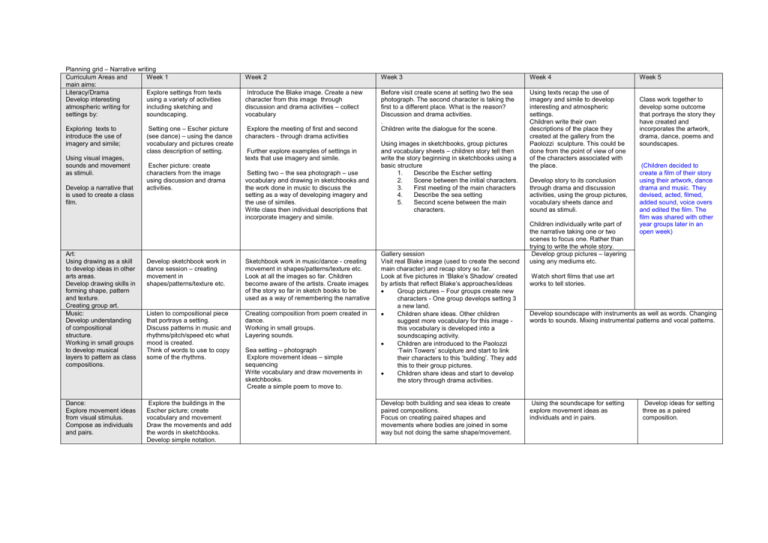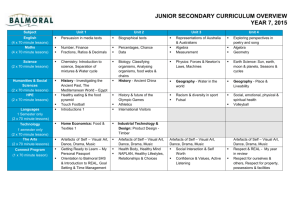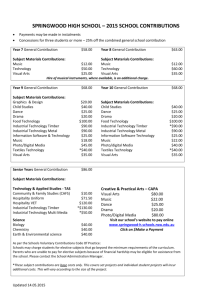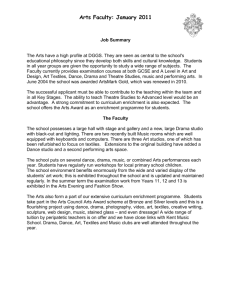Planning grid – Narrative writing
advertisement

Planning grid – Narrative writing Curriculum Areas and Week 1 main aims: Literacy/Drama Explore settings from texts Develop interesting using a variety of activities atmospheric writing for including sketching and settings by: soundscaping. Exploring texts to introduce the use of imagery and simile; Using visual images, sounds and movement as stimuli. Develop a narrative that is used to create a class film. Art: Using drawing as a skill to develop ideas in other arts areas. Develop drawing skills in forming shape, pattern and texture. Creating group art. Music: Develop understanding of compositional structure. Working in small groups to develop musical layers to pattern as class compositions. Dance: Explore movement ideas from visual stimulus. Compose as individuals and pairs. Setting one – Escher picture (see dance) – using the dance vocabulary and pictures create class description of setting. Escher picture: create characters from the image using discussion and drama activities. Week 2 Week 3 Week 4 Introduce the Blake image. Create a new character from this image through discussion and drama activities – collect vocabulary Before visit create scene at setting two the sea photograph. The second character is taking the first to a different place. What is the reason? Discussion and drama activities. . Children write the dialogue for the scene. Using texts recap the use of imagery and simile to develop interesting and atmospheric settings. Children write their own descriptions of the place they created at the gallery from the Paolozzi sculpture. This could be done from the point of view of one of the characters associated with the place. Explore the meeting of first and second characters - through drama activities Further explore examples of settings in texts that use imagery and simile. Setting two – the sea photograph – use vocabulary and drawing in sketchbooks and the work done in music to discuss the setting as a way of developing imagery and the use of similes. Write class then individual descriptions that incorporate imagery and simile. Develop sketchbook work in dance session – creating movement in shapes/patterns/texture etc. Sketchbook work in music/dance - creating movement in shapes/patterns/texture etc. Look at all the images so far. Children become aware of the artists. Create images of the story so far in sketch books to be used as a way of remembering the narrative Listen to compositional piece that portrays a setting. Discuss patterns in music and rhythms/pitch/speed etc what mood is created. Think of words to use to copy some of the rhythms. Creating composition from poem created in dance. Working in small groups. Layering sounds. Explore the buildings in the Escher picture; create vocabulary and movement Draw the movements and add the words in sketchbooks. Develop simple notation. Sea setting – photograph Explore movement ideas – simple sequencing Write vocabulary and draw movements in sketchbooks. Create a simple poem to move to. Using images in sketchbooks, group pictures and vocabulary sheets – children story tell then write the story beginning in sketchbooks using a basic structure 1. Describe the Escher setting 2. Scene between the initial characters. 3. First meeting of the main characters 4. Describe the sea setting 5. Second scene between the main characters. Gallery session Visit real Blake image (used to create the second main character) and recap story so far. Look at five pictures in ‘Blake’s Shadow’ created by artists that reflect Blake’s approaches/ideas Group pictures – Four groups create new characters - One group develops setting 3 a new land. Children share ideas. Other children suggest more vocabulary for this image this vocabulary is developed into a soundscaping activity. Children are introduced to the Paolozzi ‘Twin Towers’ sculpture and start to link their characters to this ‘building’. They add this to their group pictures. Children share ideas and start to develop the story through drama activities. Develop both building and sea ideas to create paired compositions. Focus on creating paired shapes and movements where bodies are joined in some way but not doing the same shape/movement. Develop story to its conclusion through drama and discussion activities, using the group pictures, vocabulary sheets dance and sound as stimuli. Children individually write part of the narrative taking one or two scenes to focus one. Rather than trying to write the whole story. Develop group pictures – layering using any mediums etc. Week 5 Class work together to develop some outcome that portrays the story they have created and incorporates the artwork, drama, dance, poems and soundscapes. (Children decided to create a film of their story using their artwork, dance drama and music. They devised, acted, filmed, added sound, voice overs and edited the film. The film was shared with other year groups later in an open week) Watch short films that use art works to tell stories. Develop soundscape with instruments as well as words. Changing words to sounds. Mixing instrumental patterns and vocal patterns. Using the soundscape for setting explore movement ideas as individuals and in pairs. Develop ideas for setting three as a paired composition.




